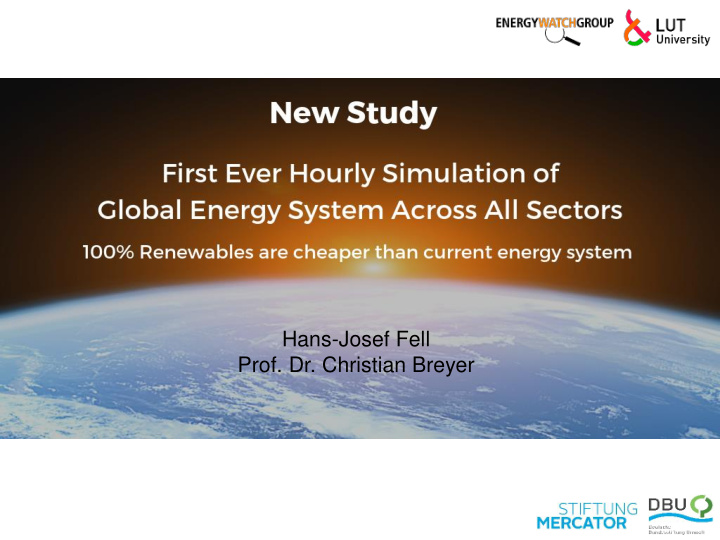



Hans-Josef Fell Prof. Dr. Christian Breyer
Global GHG Emissions Must Come to Zero around 2030 to Reach the 1.5°C Paris Target Delaying the peak by further 7 years gives too little time to transform the economy Peaking emissions by 2016 would have given us 25 years to reduce emissions to zero
New Study by EWG & LUT Shows: The energy transition is not a question of technical feasibility or economic viability, but one of political will. 100% renewable energy worldwide is more cost effective than the current energy system and leads to zero emissions before 2050. Largely domestic energy systems based on 100% renewables will create energy independence and support millions of local jobs in the energy sector.
Solar and Wind Will Dominate the 100% Renewable World Biomass/ Primary energy source Solar Wind Hydro Geo-thermal Waste Share in 2050 69% 18% 6% 3% 2%
Policy Recommendations Feed-in-tariffs crucial until 40 MW (GET-FiT) Not successful: Auctions for utility-scale projects Certificate • Abolish fossil and nuclear subsidies systems Carbon, methane, radioactivity tax Emission • trading Research, education & campaigning Reducing licensing obstacles
Global Overview The world is structured into 9 major regions, which are further divided to 145 sub-regions Some sub-regions represent more than one country, others parts of a larger country The sub-regions are interconnected by power lines within the same country The results shown are for the Power, Heat, Transport, Desalination sectors The energy transition scenario is carried out in full hourly resolution for all energy sectors In total 106 different technologies are applied
Long-term Energy Demand Final energy demand grows by 1.0% per year, while energy services grow faster Broad electrification leads to only 0.5% per year in primary energy demand growth World population grows from 7.2 billion (2015) to 9.7 billion (2050) Substitution of inefficient combustion processes by electric solutions where possible Processes of 2015 for energy services in 2050 would double primary energy demand Fossil fuels are practically substituted by renewable electricity (mainly solar PV, wind)
Energy System Costs Levelised cost of energy decline from 54 €/MWh (2015) to 53 €/MWh (2050) Fuel costs diminish through the transition period, while capital expenditures dominate Costs are well spread across a range of technologies with major investments for solar PV, wind energy, batteries, heat pumps and synthetic fuel conversion up to 2050 The cumulative investment costs are about 67,200 b€
Electricity Supply and Storage Electricity generation covers demand of all sectors Solar PV supply increases from 32% in 2030 to about 73% in 2050 becoming main energy source Wind energy very important in Northern hemisphere Batteries store 92% of all to be stored electricity Heat is mainly stored in thermal energy storage Gas storage contributes around 39% of the heat storage output in 2050, mainly for seasonal demand
Regional Variations Solar PV dominates most of regions around the world and particularly in the Sun Belt Wind energy drives systems in the Northern and Southern hemispheres with excellent wind conditions and lacking seasonal solar energy Some regions are further complemented with hydropower to form a mixed system
Transport Sector Transportation demand is assumed to triple till 2050 Final energy demand and energy cost remain stable, thanks to broad electrification and low electricity cost Fossil fuel costs are substituted by capital expenditures and some sustainable biofuels Liquid fuels (31%) and hydrogen (26%) produced by electricity contribute substantially to the final energy demand in 2050, mainly for marine and aviation
Greenhouse Gases Emissions Greenhouse gases (GHG) emissions can be reduced from around 30,000 MtCO 2eq in 2015 to zero by 2050 across all energy sectors Remaining cumulative GHG emissions comprise ca. 422 GtCO 2eq from 2018 to 2050 The presented 100% RE scenario is compatible with the Paris Agreement for 1.5 ⁰ C
Jobs Prospects – Power Sector Total direct energy jobs are set to increase with the initial ramp up of installations from about 20 million in 2015 to around 35 million by 2050 Loss of coal and other fossil fuel related jobs are more than compensated by new jobs Solar PV emerges as the prime job creator with over 22 million jobs by 2050 Operation and maintenance jobs continue to grow through the transition period and become the major job segment by 2050 with 50% of total jobs
Key Aspects 1.5 ° C scenario with zero GHG emissions in 2050 Specific energy cost shrink slightly Broad electrification of the entire energy system Energy services expand, while primary energy grow slowly More renewable energy leads to more jobs Solar photovoltaic, wind energy, batteries, heat pumps and synthetic fuel conversion technologies are central Methods used: full hourly and high geo-spatial resolution and cost optimisation for applied constraints No risk technologies required Political will and ambitious execution drive transition
The study was co-funded by: For more information please visit: www.energywatchgroup.org Hans-Josef Fell fell@hans-josef-fell.de Prof. Dr. Christian Breyer christian.breyer@lut.fi
Recommend
More recommend